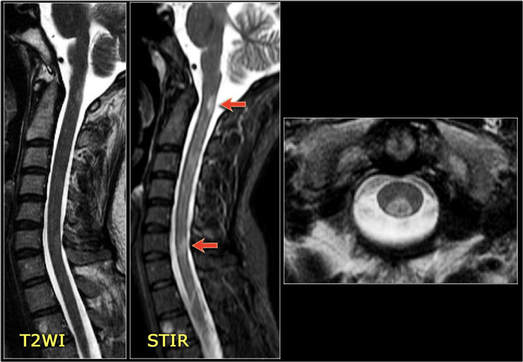by B. Hilton
Please refer to Picture
T2WI hyper intensity of the spinal cord (white patches on spinal cord) is a risk factor for CSM which indicates surgery in the future despite asymptomatic patients
Cervical spondylotic myelopathy (CSM) is a clinical diagnosis. By this, we mean that CSM is not diagnosed on the basis of an MRI scan alone. Rather, it is the combination of clinical signs and symptoms of myelopathy with an MRI scan showing cervical spinal cord compression (CSCC). Symptoms of myelopathy include: limb weakness, numb and clumsy fingers, instability and falling over, bladder and/or bowel disturbances. CSM can then be managed with an operation to decompress the spinal cord, which will help to prevent disease progression and hopefully give some symptomatic improvement.
Therefore, symptoms + MRI scan showing CSCC= CSM = surgery*
However, it is now becoming better understood that as we age, CSCC becomes more and more common. This is often through natural wear and tear changes of the bones and joints in the neck. However, not all people with CSCC have symptoms of myelopathy. This poses a problem. What is the best management plan for those people with compression of their spinal cord but no (or very minor) symptoms of myelopathy? Witiw et al. recently decided to address this very question.
In order to figure out the best management plan for this group of people with cord compression but little or no myelopathic symptoms, Witiw’s group looked at the published medical literature dealing with patients who fell into this category. They found that overall if you have cord compression but no symptoms of myelopathy, the risk of developing myelopathy in the future is relatively low. Therefore, it is usually best not to operate in these cases. Instead, patients should be given clear advice on the symptoms of myelopathy so that they can watch out for them and should be followed-up in 6 months to 1 year to ensure no myelopathy has developed. Furthermore, these patients should avoid high-risk activities that may aggravate their necks such as “downhill skiing or snowboarding, mountain biking, or contact sports”.
The caveat to the above recommendations is that surgery may be indicated for patients with CSCC but no symptoms of myelopathy if they have one or more risk factors for developing myelopathy in the future. These risk factors are:
abnormalities on electrophysiological testing [sometimes referred to as ‘nerve conduction studies’, these tests show problems in the nerves coming out of the spinal cord down the arms]
symptoms of cervical radiculopathy [e.g. pain, sensory disturbance, or weakness in a specific nerve pattern down one or both arms]
T2WI hyperintensity of the spinal cord [white patches on the cervical spinal cord seen on an MRI scan]
Witiw et al. recommend that even if a patient with one of these risk factors does not want an operation right away, it is best to follow them up more closely to monitor for myelopathy or symptom worsening, in which case an operation is the usually the best course of management.
Overall, further work is needed to confirm whether this approach towards asymptomatic people with CSCC is ideal. However, Witiw et al.’s work provides an excellent summary of current medical knowledge of how best to manage this subset of people.
*This is of course a very simplified account; an operation is not appropriate in all cases.
